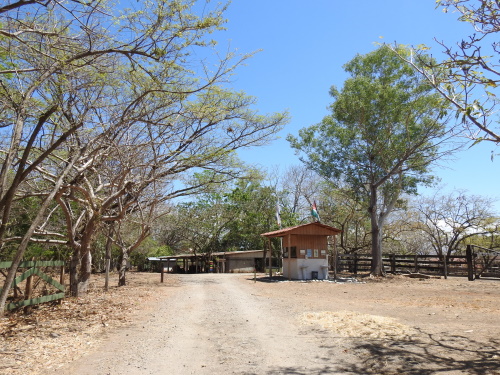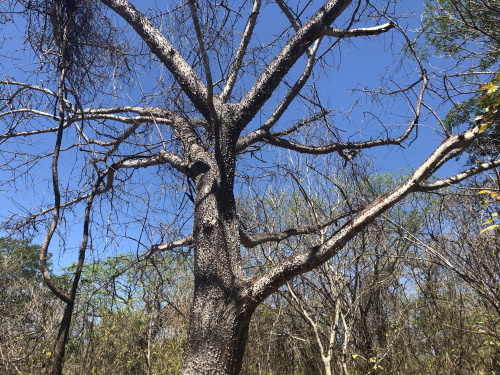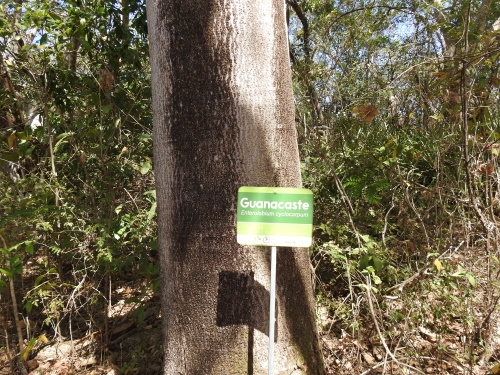Blog WHS Visits
WHS #744: Guanacaste
Like Talamanca, Guanacaste is a vast area which value is hard to summarize in one phrase. One can easily spend days visiting its specific features, its OUV ranges from the marine (turtle nesting sites) to the terrestrial with dry tropical forests and much more. I am only the third reviewer on this website, 11(!) years after the last one. However parts of the included area close to Liberia are quite popular with the beach tourists that mostly come from the USA.
There’s a similar choice to make as with Talamanca as to which included area to visit. The WHS comprises a contiguous area of seven protected zones. I did a half-day visit from Liberia to “Horizontes Forestry Experiment Station”. I had also wanted to add a stay near “Rincon de la Vieja National Park” (probably the most touristy part), but a rescheduling of my flight back to Europe forced me to cut my stay short.
Horizontes was a late discovery during my preparations. It needed pre-booking for Covid reasons as well, however the process wasn’t as smooth as with other parks in Costa Rica. Payment could only be done by bank transfer in USD (15) or colones, for which my bank asked a 50 EUR fee. Fortunately, Wise did it much cheaper.
This former cattle ranch has been turned into a cultivation site for native forest species and their associated forest ecosystems. It lies almost directly behind Liberia airport. Only the final 4km is on a dirt road with some rough patches (it needs a high clearance vehicle). I received a warm welcome and it was explained to me that there are several trails that I was free to walk. They are signposted with coloured arrows, it just felt like hiking in The Netherlands again! I was asked if I came for birding – apparently that is the only reason tourists show up here once in a while.
This park protects a Pacific dry forest ecosystem. Tropical dry forests are rare and threatened around the world – the only other 2 WHS that hold them are Kakadu NP and Thungyai-Huai Kha Khaeng. It surely felt and looked like Australia; I had arrived a little after 8 am in the already blistering heat and I saw the remains of some wildfires on the way out there.
I walked the Green trail, Sendero El Guaracho, and the loop in the Arboretum. The difference between them is that the trees in the Arboretum have shields with their species name on them, while those on the Green trail only have numbers without explanation. I don’t have a great interest in trees so it wasn’t too exciting. The trails are on easy terrain but the heat quickly gets to you. I started looking for birds and did manage to score a black-headed trogon.
I spent around 2.5 hours at the site. The trails are short and easy - except for the lack of shade. However it felt good to be outside of Costa Rica's manicured, tourist friendly parks (having visited Manuel Antonio NP the day before, which is the worst example of that case). On the way out I encountered a large spiny tail iguana on the road – I guess lizards at least enjoy this kind of environment and the dry leaves on the ground.
Els - 18 April 2021
Comments
Esteban Cervantes Jiménez (Vantcj1) 20 April 2021
Yes, AC Guanacaste is a site which would require some days for a fuller appreciation. Additionally, March/April is the latest part of the dry season so it will be really be hot and dry in this part of the country (the hottest and driest of them all), though an upside is the blooming of trees like cortez amarillo, roble de sabana and others. A lot of water, sunblock and additional cover, are also a must, though it will still be unpleasantly hot, even for people from the Central Valley, like me.
The rainy season, which usually doesn't start there until late May (this year is an exception, it is already starting) may provide better conditions, greener landscapes and abundant water in stational creeks/rivers.
Personally, I haven't been to Horizontes Experimental Station so the idea of the Arboretum seemed a good one with the lack of available time, but it seems it isn't as good, though may be more enjoyable for birdwatchers.
I am of the idea-having visited 3 of the several protected areas- that the best option is to combine a lower and a higher location, respectively Santa Rosa National Park and Rincón de la Vieja National Park. The lower will provide a more typical dry forest and access to a marine sector, a higher location will provide better landscapes, more luscious rivers and more importantly, the chance to see the transition between dry and wet pre-montane forests.
In the case of Santa Rosa, I've been there 3 times: 2 to the Historical Sector (besides the FTLS Casona Santa Rosa, which now mostly lacks authenticity due to an intentional fire in 2001... still worth some minutes through its corrals, the Indio Desnudo trail is a great chance to see the typical dry forest...all times there I have seen several animals) and 1 to the former Murciélago sector, which is now closed. Additionally, the marine sector is interesting: Naranjo beach is great, landscape-wise (even for people who're not interesting in swimming) and I've heard that tours to Nancite beach can be done during turtle hatching season. The Murciélago islands can be accessed by sea (so $$), but I know of friends who have hiked there and really had great experiences, these islands have a great on-land and marine biodiversity, I haven't been there, but hope to go some time.
Rincón de la Vieja is probably my second most favorite Costa Rican national park, after Talamanca's Chirripó: I went twice in the 90s, so a lot has changed (back then it was possible to go camping, the trail up to the volcano is currently closed due to its activity). Las Pailas sector is mostly interesting for the abundance of volcanic features, and has great rivers, La Cangreja waterfall was my favorite, however, the most interesting thing was the hike to the volcano, because the transition of life zones was very clear, you could easily spot animals (me and my mother were even followed some kms by a feline, of course nothing happened) and many species of orchids. We also back then marginally visited Santa María sector (another volcano, though inactive, it seemed very forested from a distance), only to the thermal waters. This sector's description shows that is really is the best option to see the transition to wetter forests, plus additional waterfalls, volcanic features, orchids and birdlife. Santa María sector is currently closed due to COVID-19 restrictions (Las Pailas, as the main sector, is open), but most probably will be reopened as soon as possible.
Regarding Guanacaste National Park, I haven't ever gone and I understand that access to any of its biological stations might be possible to not only scientists, but has to be requested well in advance. It seems that it may be very interesting (it also has some archaeological remains, it has both lowlands and highlands, so all life zones), but to me keeps on being a pending task.
Lastly, Guanacaste Conservation Area has one unified webpage, I think it's a great source of information/updates: https://www.acguanacaste.ac.cr/turismo
Zoe 19 April 2021
Huai Kha Khaeng only by car. Once you get to the ranger station there isn't much to do in terms of hiking afaik, although you can freely go into the park area by yourself by following the jeep trails. Lots of lizards roaming around, too. Enjoy the heat. :)
Els Slots 18 April 2021
Thungyai-Huai Kha Khaeng is also pretty difficult I believe. Kakadu may be the easiest, with a car.
Michael Ayers 18 April 2021
Guanacaste is one of those Sites that is a little difficult to organize. In theory, I have been there twice, but I am still only 90% sure that I stood on the core zone.
I should be visiting Thungyai-Huai Kha Khaeng within a week. Perhaps someone else would volunteer to go to Kakadu soon, so we can cover all three dry forest Sites during this month :-)


